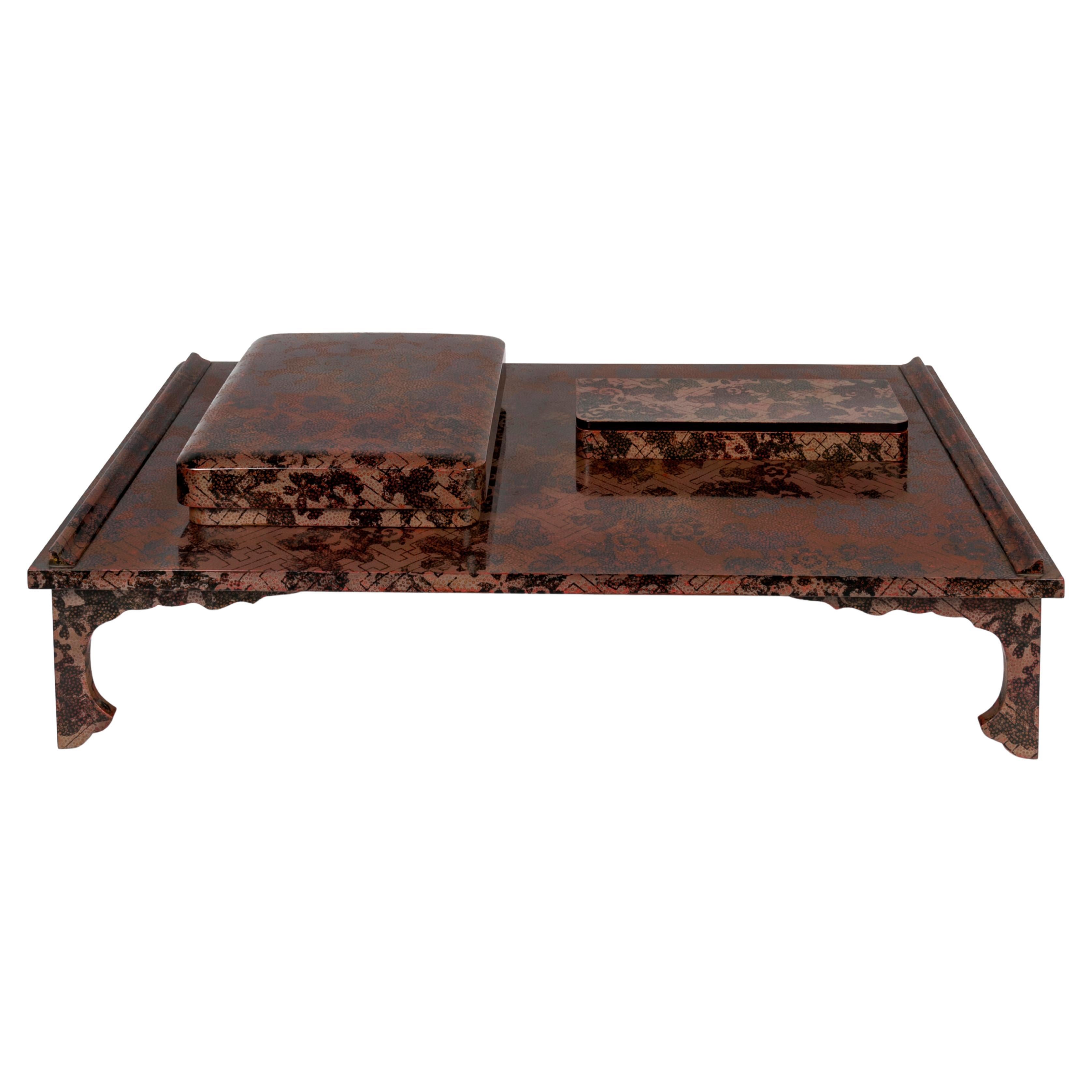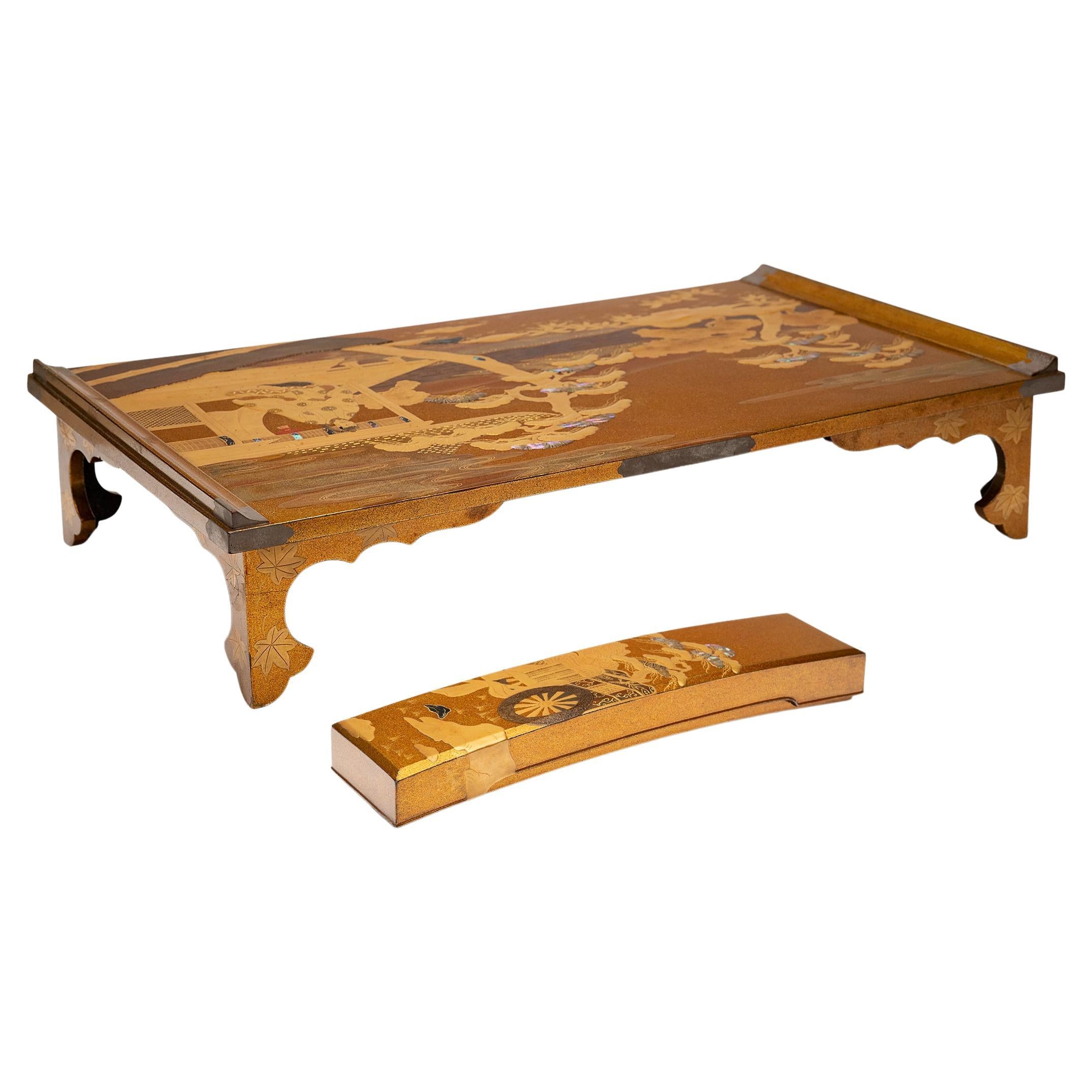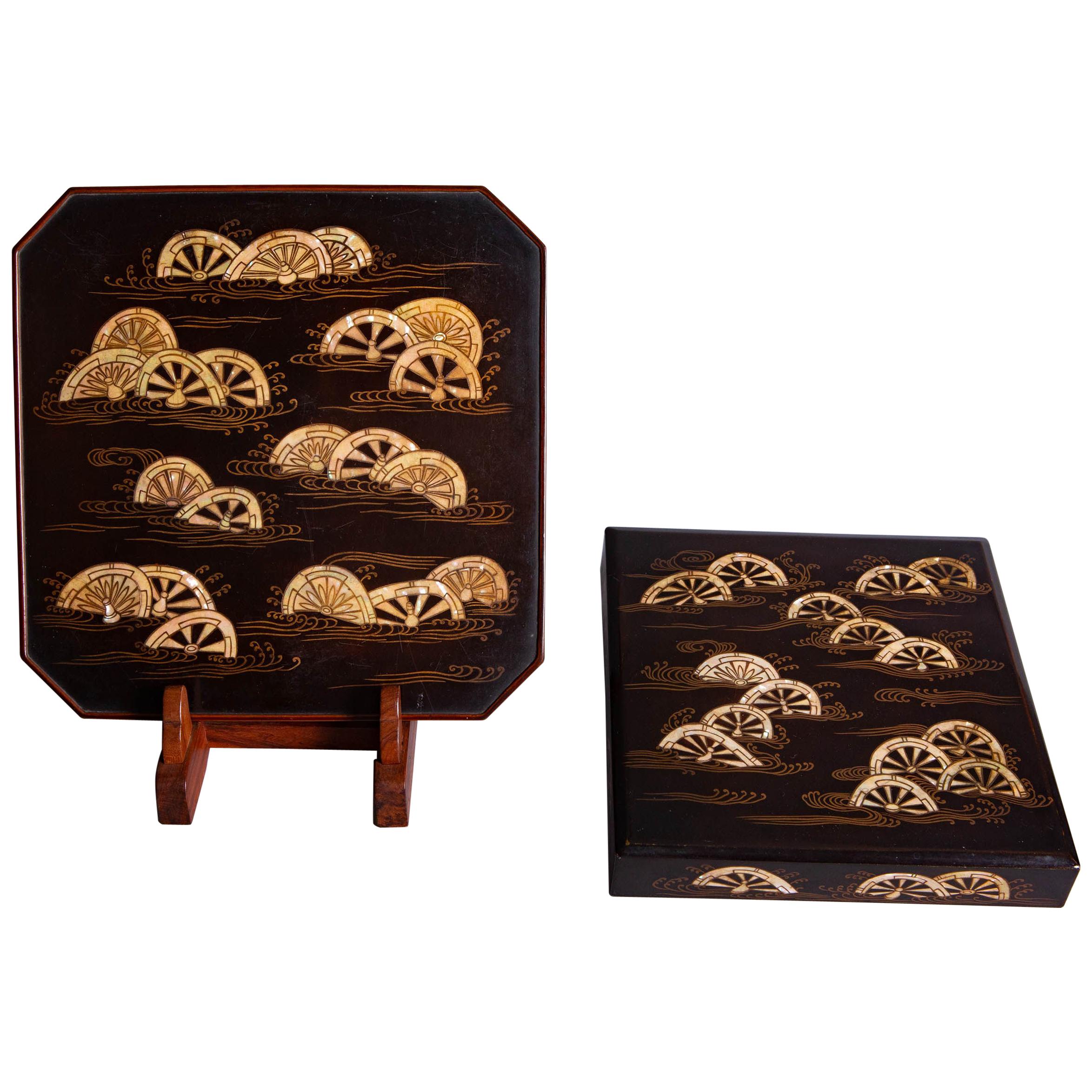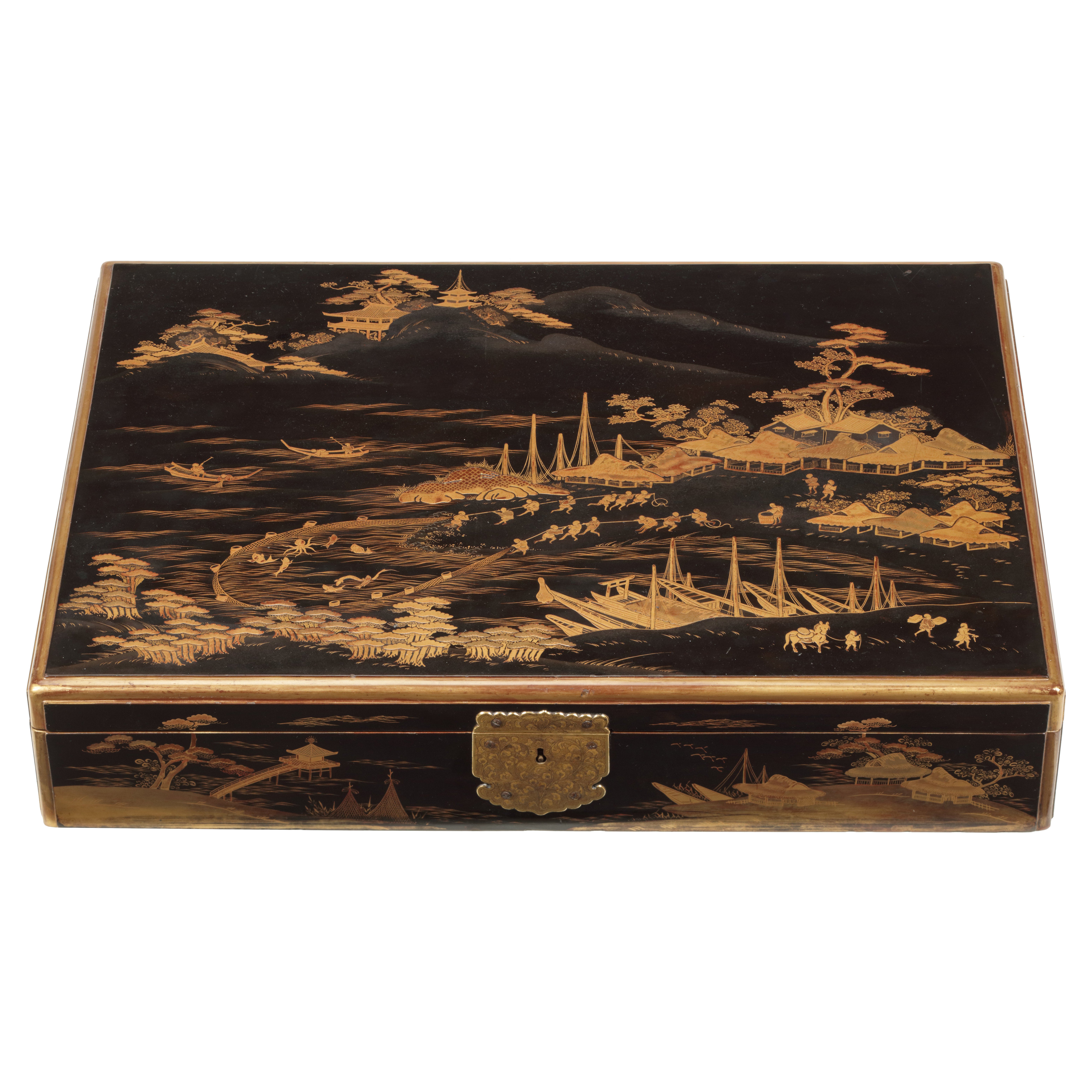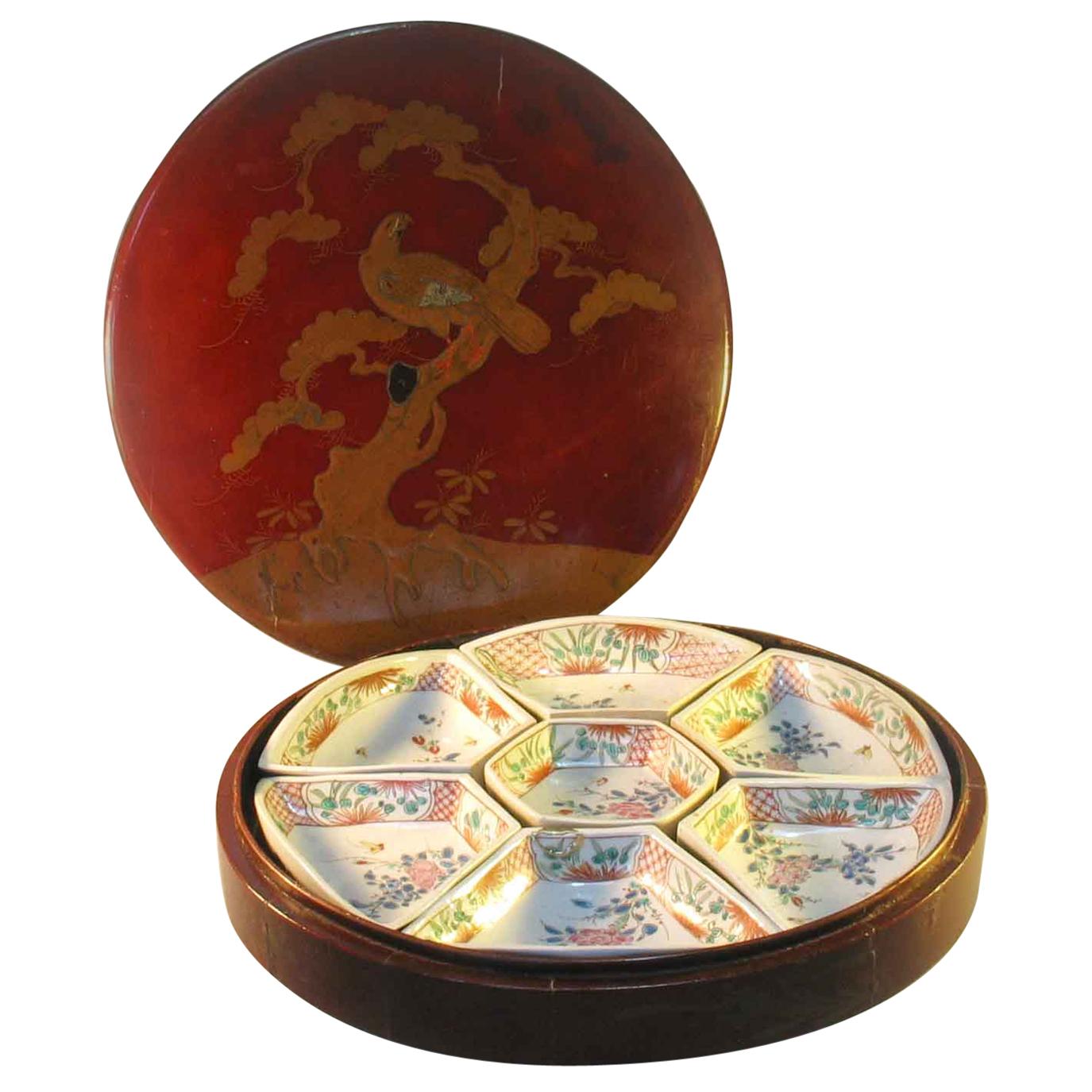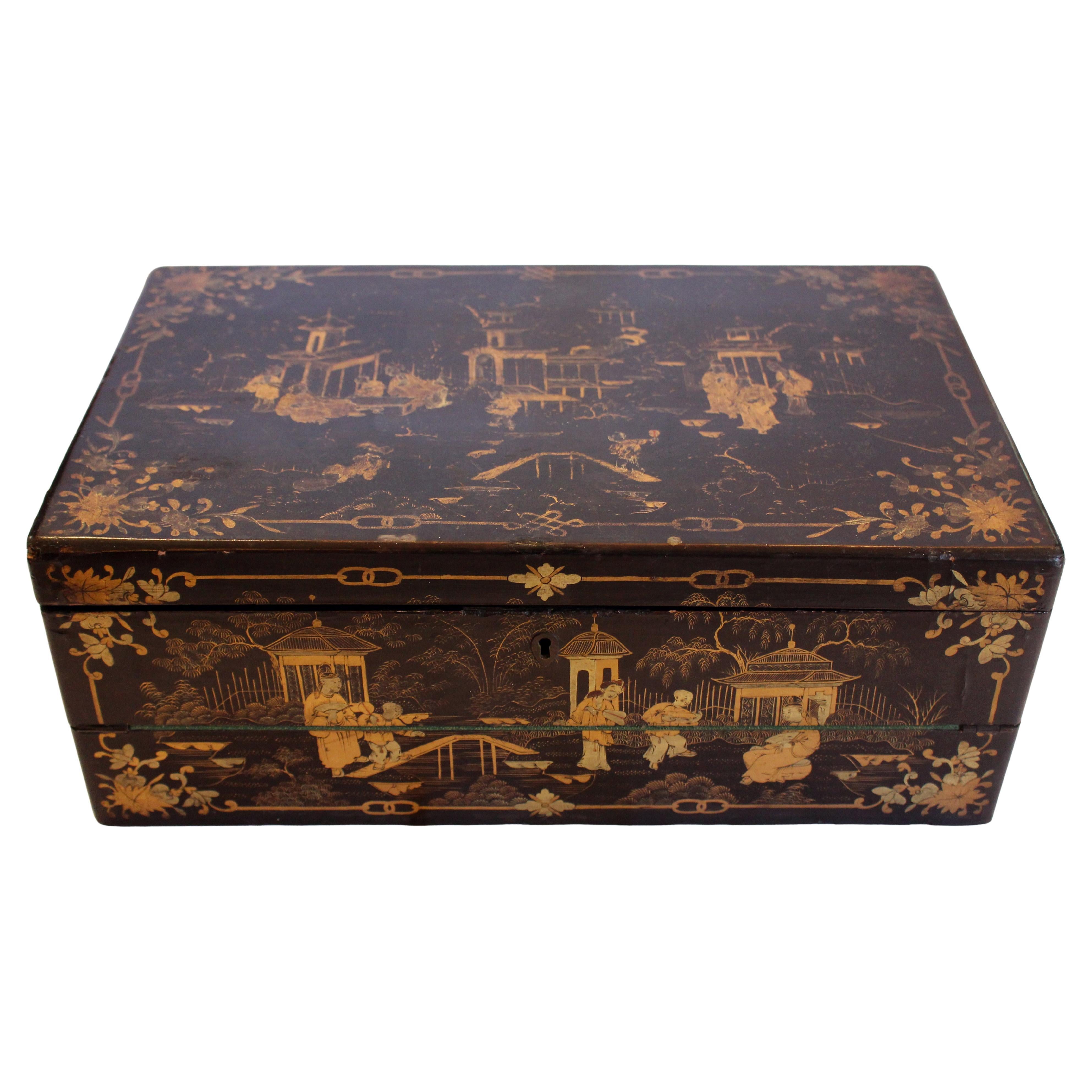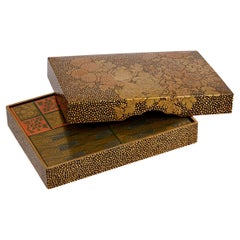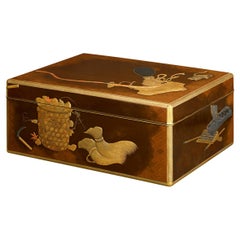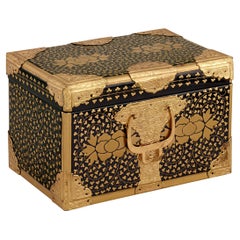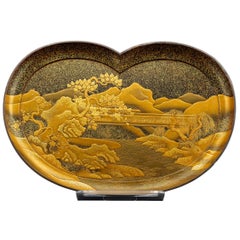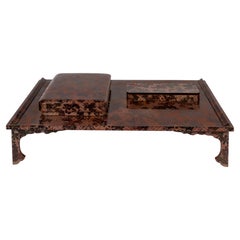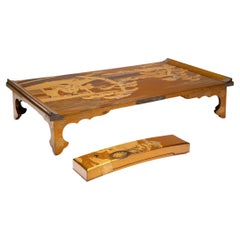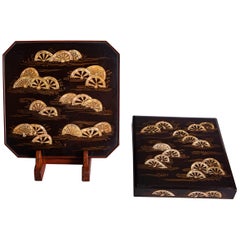Items Similar to Japanese Meiji Lacquer Writing Set
Want more images or videos?
Request additional images or videos from the seller
1 of 5
Japanese Meiji Lacquer Writing Set
$28,500
£21,636.71
€24,747.79
CA$39,818.63
A$44,287.01
CHF 23,125.30
MX$538,925.82
NOK 295,345.39
SEK 276,981.87
DKK 184,702.20
Shipping
Retrieving quote...The 1stDibs Promise:
Authenticity Guarantee,
Money-Back Guarantee,
24-Hour Cancellation
About the Item
This remarkable Japanese portable writing set contains the instruments of sublime artistic expression. Also known as a yatate, this Meiji-period set includes a low writing table, an ink stone, or suzuri and water dropper, or mizusashi, in a compact or silk-covered saturation pad, and a set of five metal implements. Incredible lacquer decoration of tree-lined, rolling hills distinguish the larger items, and all of these are held inside a finely crafted box of bare wood, which is marked with a Japanese inscription and bound with a ribbon handle.
Yatate, which means “arrow stand,” were first invented during the Kamakura period (1185-1333). Before they were invented, whenever anyone wanted to write or draw in ink, he had to make his own by grinding the ink stick in water on the grinding stone. Samurai warriors often had to write letters and reports from the field, and therefore carried their writing tools with them, including a small grinding stone set in a drawer at the bottom of their arrow quiver. This grinding stone became known as the yatate no suzuri (arrow stand's grinding stone), then simply “yatate.” As it was burdensome to have to pull out one’s writing implements every time one needed to write, the idea of saturating a piece of cotton or silk in liquid ink was born. This could be carried about in a simple container without any worry of spills. If a dispatch was required, the warrior need simply to slide open the lid and press his brush into the cotton,
circa 1890
Measures: 9" wide x 1 1/2" deep x 10 3/4" high.
- Dimensions:Height: 10.75 in (27.31 cm)Width: 9 in (22.86 cm)Depth: 1.5 in (3.81 cm)
- Style:Meiji (Of the Period)
- Materials and Techniques:
- Place of Origin:
- Period:
- Date of Manufacture:circa 1890
- Condition:
- Seller Location:New Orleans, LA
- Reference Number:Seller: 29-91141stDibs: LU891110411843
About the Seller
5.0
Recognized Seller
These prestigious sellers are industry leaders and represent the highest echelon for item quality and design.
Established in 1912
1stDibs seller since 2010
109 sales on 1stDibs
Typical response time: 3 hours
- ShippingRetrieving quote...Shipping from: New Orleans, LA
- Return Policy
Authenticity Guarantee
In the unlikely event there’s an issue with an item’s authenticity, contact us within 1 year for a full refund. DetailsMoney-Back Guarantee
If your item is not as described, is damaged in transit, or does not arrive, contact us within 7 days for a full refund. Details24-Hour Cancellation
You have a 24-hour grace period in which to reconsider your purchase, with no questions asked.Vetted Professional Sellers
Our world-class sellers must adhere to strict standards for service and quality, maintaining the integrity of our listings.Price-Match Guarantee
If you find that a seller listed the same item for a lower price elsewhere, we’ll match it.Trusted Global Delivery
Our best-in-class carrier network provides specialized shipping options worldwide, including custom delivery.More From This Seller
View AllGold Lacquer Incense Box
Located in New Orleans, LA
A Gold Lacquer Kōbako (Incense Box)
Edo Period (1615–1868), Circa 1850
This exquisite gold lacquer kōbako (incense box) exemplifies the refined craftsmans...
Category
Antique 19th Century Japanese Edo Decorative Boxes
Materials
Gold, Silver, Gold Leaf
$9,850
Japanese Lacquer Box
Located in New Orleans, LA
This exquisite Meiji-period lacquer document box known as a ryoshibako showcases the meticulous artistry of maki-e, a technique of raised lacquer decoration. Adorned with gold and vi...
Category
Antique 19th Century Asian Meiji Lacquer
Materials
Gold
$39,850
Edo-Period Lacquerware Chest
Located in New Orleans, LA
Edo-Period Lacquerware Chest
19th-century
This exquisite chest, inspired by Hasami-Bako travel trunks, is a striking example of Japanese lacquerware. The hiramaki-e technique—applie...
Category
Antique 19th Century Japanese Edo Decorative Boxes
Materials
Gold
Japanese Lacquer Tray
Located in New Orleans, LA
As beautiful as it is practical, this Japanese Meiji-period lacquered tray is distinguished by its exceptional craftsmanship. It exhibits a phenomenal artistry as the entire tray is ...
Category
Early 20th Century Japanese Meiji Lacquer
Materials
Lacquer
$8,850
Japanese Lacquer and Gold Tray
Located in New Orleans, LA
This Meiji-period lacquer tray represents the mastery of Japanese craftsmen in the art of lacquer work. Precious materials are precisely inlaid in the lacquer base, creating a highly...
Category
Antique Late 19th Century Asian Meiji Lacquer
Materials
Gold
Satsuma Incense Burner
Located in New Orleans, LA
This Japanese Satsuma incense burner is a decorative work of art from the Meiji period, distinguished by its exquisite craftsmanship and intricate detailing. Made from fine earthenwa...
Category
Antique 19th Century Japanese Meiji Ceramics
Materials
Earthenware
$3,450
You May Also Like
Japanese writting set in waqasa lacquer including bundai ryoshibako and fudebako
Located in PARIS, FR
Set of bundai, ryōshibako and fudebako in wakasa lacquer with an old rose background and black traditional Japanese patterns.
The saya pattern (or sayagata) is composed by Chinese svastikas. This symbol linked to Buddhism, mean intelligence, power and peace. It is a good omen sign.
The kanoko pattern reminds stains on fawn back.
The sakura (cherry blossom) pattern is emblematic of Japan. The blossoming in a short time marks spring beginning and is a symbol of renewal and ephemeral beauty.
There are also traces of calligraphy brush, in reference to the function of the objects.
Bundai is a low table used to put books or scrolls and, later, to write.
Rectangular ryōshibako (letter and document box) with a slightly domed
Fudebako (pencil case) of rectangular format very narrow in its length with two rounded corners, flat cover.
Wakasa lacquerware...
Category
Early 20th Century Japanese Taisho Lacquer
Materials
Lacquer
Japanese Meiji Gilt Lacquer Writing Desk & Poem Box
Located in Chicago, IL
With intricate construction and exquisite decoration, this fine tabletop writing set is a masterpiece of Japanese lacquerware. The matching set includes a writing table (bundai) and poem box (tanzaku bako), both decorated with gilt lacquer in the style of takamaki-e and hiramaki-e urushi lacquer.
Framed by everted ends, the lacquered table top is masterfully worked, depicting a robed man seated on a veranda within an idyllic mountain-and-water landscape. Swirling clouds drift overhead and pine trees bend towards the sky, formed of raised lacquer (takamaki-e) and mother of pearl inlay (raden). Dark lacquer at the corners imitate metal hardware and the sculptural corner legs are decorated with raised motifs of maple leaves.
The writing table includes a matching poem box (tanzaku bako), used for storing paper cards of painted calligraphy and poetry. The lid is similarly decorated in shimmering gilt lacquer with a raised design of a fine carriage beneath a pine tree, draped in cloths and shaded by bamboo blinds...
Category
Early 20th Century Japanese Meiji Lacquer
Materials
Mother-of-Pearl, Wood
18th Century Japanese Lacquer Writing Box and Tray Set
Located in Hudson, NY
Wheels Submerged in flowing water motif, believed to be a subject popular in samurai families. Example of the same subject matter in Tokyo National Museum.
Category
Antique 18th Century Japanese Lacquer
A superb Japanese export lacquer writing box
Located in Amsterdam, NL
Kyoto, circa 1680
The writing box has bevelled edges and a kabusebuta (overhanging lid), and is completely covered in black lacquer in maki-e and decorated in gold, silver and red h...
Category
Antique 17th Century Japanese Lacquer
Materials
Lacquer
Japanese 7-Pcs, Arita Sweetmeat Set & Matching Lacquer Box Meiji Period, 1880s
Located in Ottawa, Ontario
A seven-piece Japanese Arita Sweetmeat set and matching lacquer box, Meiji period (1880-1890). Comprising of a central hexagonal dish and six-fan shaped ...
Category
Antique Late 19th Century Japanese Meiji Lacquer
Materials
Porcelain, Lacquer
c. 1860 Chinese Lacquer on Wood Writing Slope
Located in Chapel Hill, NC
Circa 1860 Chinese lacquer on wood writing slope. Made for the English market. Fold over writing surface. Secret drawers. Losses & rubbing commensurate with age, use & delicacy of ma...
Category
Antique Mid-19th Century Chinese Chinese Export Desk Sets
Materials
Lacquer
More Ways To Browse
Japanese Wood Objects
Japanese Stone Art
Meiji Wood
Meiji Wood Furniture
Used Stone Tools
Antique Quiver
Japanese Containers
Japanese Brushes
Scholar Stone
Used Wood Arrows
Japanese Samurai Art
Wood Warrior
Antique Brush Set
Antique Japanese Stone
Japanese Warrior
Meiji Silk
Japanese Meiji Period Box
Antique Arrow Quiver
